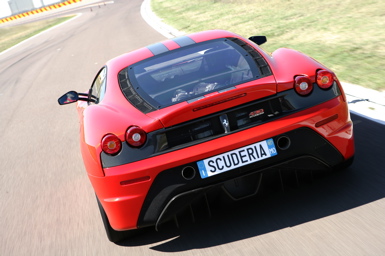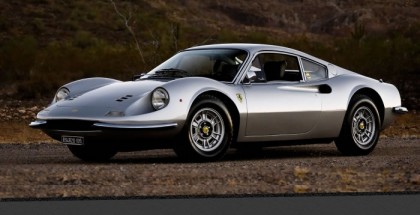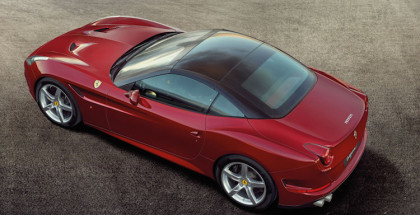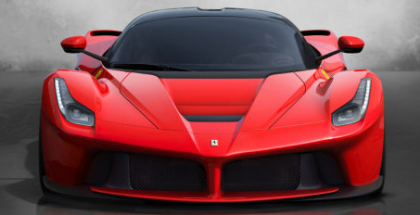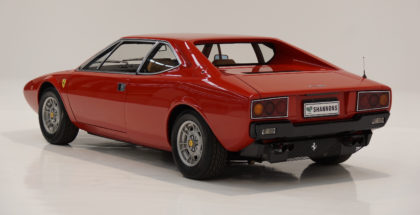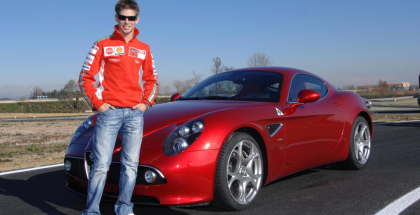Superfast successor to the 360 Challenge Stradale
The successor to the stripped down, beefed up 360 Challenge Stradale, the new F430 Scuderia sets new standards for supercars, surprisingly not only in performance and handling, but also in environmental friendliness and fuel consumption – not an area traditionally of concern to Ferrari and its customers.
At ItalianCar we were recently privy to a media viewing of the new model, a beauty in light metallic blue, with the obligatory (well, technically it’s an option) racing stripe down the middle. As you can see the stripe is not quite as ‘in your face’ as the Challenge stripe was. This particular car, which is doing a round-the world trip to showcase the Scuderia, is a left hand drive version already sold to a customer in Italy.
Ferrari Australia have, as ever, provided us with exhaustive information on the new model, which we reproduce, largely unexpurgated, below.
Much more than a new version of the Ferrari F430 – already a supercar benchmark in its own right – the V8-engined 430 Scuderia takes all the latest technology from Ferrari’s Formula One and road cars to produce a new model that is much more than just faster. It is as quick around the Ferrari Fiorano test track, a microcosm of all the most difficult and testing Formula One tracks in the world, as the Ferrari Enzo – the V12-powered car that was the epitome of technology transfer from race track to road.
The 430 Scuderia crushes the benchmark 0-100 kmh acceleration test in 3.6 seconds, blasts to 200 kmh in 11.6 seconds and dispatches the standing kilometer in 20.9 seconds en route to a top speed in excess of 320 kmh.
But straight-line performance is only part of the Ferrari 430 Scuderia story.
Lightweight, simple and striking with a distinctive engine and exhaust sound: every last detail of the Ferrari 430 Scuderia exudes uncompromising sportiness as a direct result of its close links to the world of racing, which is reflected in the car’s name: “Scuderia”.
Seven-times World Champion Michael Schumacher was also involved in the car’s development, with the result that the most advanced single-seater technology is now available to Ferrari’s sportiest and most passionate clients. With a dry weight of 2775 lb (1250 kg) and 510 hp delivered at 8500 rpm by its naturally aspirated 4308 cm3 V8 engine, the 430 Scuderia boasts an extraordinarily low weight-power ratio of just 2.45 kg/hp, which allows it to sprint from 0 to 100 km/h in just 3.6 seconds.
It can also complete a lap at Fiorano in a time comparable to that of the Enzo, the Ferrari that has come to epitomise Maranello’s philosophy of transferring F1 content to its road cars. Thanks to its sophisticated aerodynamics, F1-SuperFast2 gearbox and E-Diff coupled with the sophisticated F1-Trac traction control system, this sporty new mid-rear engined berlinetta combines ultra-nimble handling with blisteringly fast acceleration.
The result? Absolutely superlative driving pleasure both on the road and on the track.
Engine and engine sound
The 430 Scuderia’s engine is an evolution of the F430’s 90° V8 which features a number of modifications to boost its specific power output from 114 hp/litre to 118 hp/litre. The inlet ducts and exhaust system have been optimised, most notably through the adoption of the exhaust geometries derived from the F430 Challenge and the use of carbon-fibre on the intake manifold and for the filter housing to aid weight reduction.
Thanks to Ferrari’s Formula 1 experience, the 430 Scuderia’s ignition system boasts special coils and, for the first time on a market-targeted car, a dedicated CPU capable of monitoring the ionising currents generated inside the combustion chamber between the spark plug electrodes. This means that every single sparking detonation is detected for every cylinder and sparking is faster and more accurate across the board.
The 430 Scuderia’s compression ratio has also been increased to 11.88:1, thanks in part to a new piston design. Particular attention was paid to achieving just the right sound from the engine and exhaust as this has always been one of the real trademarks of every Prancing Horse car. Cutting-edge calculation tools were employed to optimise the 430 Scuderia’s intake and exhaust systems and sound damping, with the result that the exhaust and engine sound inside the cabin is clear, powerful and particularly thrilling in full acceleration.
F1-Superfast2 Gearbox
The F1-SuperFast2 is an evolution of the F1 gearbox used on all of Ferrari’s models and reduces gear-shifting times to just 60 ms, the fastest time of any of the models in the Prancing Horse range, the lowest overall of any automated-manual gearbox. Significantly, Ferrari calculates the gear changing time according to the acceleration gap, not just the time it takes to engage the gear.
The various stages are implemented in parallel (non-sequentially). In the case of the F1-SuperFast2, genuinely innovative integrated engine and gearbox management programmes allow the combined disengaging/engaging of the gears to take place partly in parallel with letting the clutch in and out.
E-Diff2: E-Diff with F1-Trac
The E-Diff2 (which is integrated with the gearbox) is one of the primary components which clearly demonstrate the 430 Scuderia’s links to the track. In use for many years now in Formula 1, it is integrated with the car’s stability control system. The 430 Scuderia is the first high performance road car after the F430 to sport an electronic differential.
Torque is continuously distributed between the wheels via two sets of friction discs (one for each driveshaft) controlled by a hydraulic actuator. The amount of torque actually transmitted to the driven wheels depends on driving conditions and brings considerable advantages in terms of performance, direction stability, active safety and handling feedback. The F1-Trac traction control system, which is also derived from Ferrari’s F1 experience, ensures that even more drivers will be able to extract the maximum performance from the car, thanks to the exceptional cornering, safety and stability it offers.
Introduced for the first time on a road car with the Ferrari 599 GTB Fiorano, it is faster and more precise than a traditional traction control system and optimises traction by modulating power delivery to help maintain the desired vehicle trajectory. The system estimates the maximum available grip thanks to continual monitoring of the relative speed of the wheels. The integrated E-Diff and F1-Trac systems offers 40% more acceleration out of corners than a traditional traction and stability control system.
Racing manettino
The manettino has already featured in several of Ferrari’s road cars but the 430 Scuderia features the special Racing version which puts the emphasis firmly on track-specific sporty driving and provides the driver with even more choice in terms of the car set-up. With this in mind, the ICE setting available with the F430 has been removed and a new CT- (Traction Control Off) setting has been introduced. This deactivates the car’s traction control, but unlike the CST position, retains the safety of the car’s stability control system to ensure a level of safety is maintained.
Another novelty with the 430 Scuderia is a button on the centre console which allows the suspension to be controlled separately from the predefined manettino strategy. This allows the driver can maintain maximum performance even on irregular road surfaces. Michael Schumacher made a particularly valuable contribution to this area of the car’s development.
In fact, he and the car development team worked together to ensure that the 430 Scuderia delivers both exceptional performance and fantastic driving pleasure which is within reach of non-professional drivers.
 Brakes
Brakes
The 430 Scuderia boasts a specific braking system featuring CCM (carbon ceramic material) discs with specific dimensions to cope with the car’s increased performance. The front discs are now 18 mm larger than those on the F430 and are designed to dissipate the extra heat created by the higher performance and are even more hard-wearing for greater efficiency. These components, together with 6-pot calipers, guarantee blistering performance at all times and, equally importantly, consistently efficient braking during prolonged track use.
Aerodynamics
The 430 Scuderia’s external styling has been honed to improve its aerodynamic efficiency by increasing overall downforce whilst still retaining the same drag values as the F430.
The aerodynamic efficiency of the newly-styled rear diffuser has been enhanced by the addition of a revised profile for spoiler at the rear of the engine cover and by the large venturis that run from the front wheel houses to the rear bumpers, achieving the patented “Base Bleed” effect developed by Ferrari as part of the FXX project. The Base Bleed effect has the double advantage of reducing the pressure in the rear wheel arch, thereby increasing downforce and lowering drag by blowing the car’s “wake”. Furthermore, the new lower sill profiles ensure a more uniform distribution of air over the lower parts to ensure uniform distribution of the vertical load between the front and the rear of the car.
Styling and personalisation
The 430 Scuderia’s ultra-sporty character and blistering performance have led to the redesign of many of its exterior and interior styling features. This was done to give the F430-inspired model its own strong personality and to further enhance the aerodynamics of what is a very extreme car.
The modifications made to the exterior focus on increasing downforce. In-depth research went into reducing the car’s weight and has led to extensive use of carbon-fibre, including some of the bodywork components. The cabin has been inspired by racing and, once again, the emphasis has been on weight reduction and using technical materials where possible. The new “Super Racing” seat boasts an all-carbon-fibre structure and is available in several different sizes as well as being manually adjustable, including a recline adjustment for the seat back.
The Carrozzeria Scaglietti Personalisation programme has also been enhanced to meet the 430 Scuderia’s specific requirements as well. The Racing and Track area, in particular, now offers carbon- fibre kits for the 430 Scuderia to enhance the message that this is a lean, track-focused driver’s car. The headlamp assembly, engine cover, front spoiler, side sill kick panels and diffuser are all available in this high tech material. There is also now a choice of wheel rim colours and a specially designed carbon-fibre helmet is available to order.
Lean, clean, green – and bright red?
The new Ferrari 430 Scuderia, also has the lowest fuel consumption and the lowest emissions of any model in the Ferrari range, a seeming contradiction in terms. But the Ferrari 430 Scuderia is living proof that the advanced technology in all areas that makes it Ferrari’s ultimate supercar, is also technology that can and will make all cars use less fuel and reduce emissions in the future.
“With such beautiful styling providing the visible promise of outstanding levels of performance, its all too easy to forget that every Ferrari is also a technical tour de force and that Ferrari is debuting technology that will, one day, become much more widely available,” says Kevin Wall, General Manager for Ferrari in Australia and New Zealand. “While today’s Ferraris may seem just a dream to many, a closer look will reveal technology that will, one day make many cars safer, cleaner and – of course – faster.”
Looking at a Ferrari that can top 320 kmh, environmental compatibility may not be the first thing that springs to mind. Yet, to achieve the remarkable performance offered by every Ferrari, the engines have to be extremely efficient, extracting every possible amount of power from the fuel provided, while meeting the latest emission standards. Technology developed for Ferraris cutting-edge V8 and V12 engines will make tomorrow’s engines cleaner and more efficient.
With the new 430 Scuderia, Ferrari’s engine designers have developed a new ‘breathing’ system for the engine that releases more power and torque from the engine, in turn making it more efficient. Therefore, it uses less fuel and cuts emissions. So although the 430 Scuderia is now as fast around the Ferrari test track as the lavishly powerful limited-production V12 Ferrari Enzo, fuel consumption is cut from 18.3 l/100 km for the normal F430 Coupe to 15.7 l/100 km for the Scuderia and carbon dioxide emissions are down from 420 to 360 g/km.
Gearbox technology debuted by Ferrari first on the race track and then in road cars, the sequential or robotized manual gearbox, has already transferred to mainstream cars and it is making those cars more economical and it cuts emissions. This is because a robotized manual not only provides better than manual transmission performance, as it slashes gearchange time to just 60 milliseconds in case of the 430 Scuderia and its new F1-SuperFast2 transmission, it also removes fuel use and emissions during gear changes to effectively nil. It is no coincidence that two of the most economical conventional cars available on the market use robotized manual transmissions.
Weight is not just the enemy of performance. The heavier a car is, the more fuel is used to move it and the more emissions are produced. Working with Alcoa, Ferrari has pioneered aluminium construction, making its cars – all of which are aluminium – lighter and more fuel efficient. Aluminium is also easier to recycle – not that Ferrari expects any of its products to be recycled any time soon – but this is, again, technology that is transferring to the mass market.
The Ferrari 430 Scuderia takes this one step further. Not only does it use aluminium and carbon fibre, which is very light and very strong, it also pioneers the use of a new material, RTM, which is almost as light and strong as carbon fibre, but is considerably lower in cost and provides an obvious transfer prospect for reducing weight in all cars.
From speeds as low as 60 kmh a car can be using more power to move air out of the way than it does to make it go down the road, so anything that can be done to cut drag will boost performance and save fuel, while cutting emissions. But at the same time, a car has to be stable in all conditions, get cooling air to the engine.
Ferrari has, once again, pioneered aerodynamic design. For example, the ‘flying buttresses’ behind the doors of 599 GTB Fiorano not only look good, they provide up to 100 kg of down force to keep the 599 glued to road, they also direct the airflow for directional stability in cross winds, yet they cause a fraction of the drag compared to conventional wings and spoilers on cars.
But the Ferrari 430 Scuderia goes one remarkable step further.
The industry-leading aerodynamic experts at Ferrari have achieved the seemingly impossible, by lifting the new car’s downforce by up to 30 kg with no increase what so ever in fuel-sapping and emissions-increasing drag.
Electronic Stability Control is the buzz word in safety circles, with calls for it to be made standard on all cars; such is its massive effect on safety. Needless to say, this is another technological area pioneered by Ferrari on and off the race track. While the systems used in conventional cars control just the brakes and the throttle, in the Ferraris at the Australian International Motor Show it’s possible to see the future of the remarkable life-saving technology.
The CST and E-Diff systems mean for all their huge performance potential, every Ferrari can be driven in every day conditions of rain and even snow and ice with ease and safety. In addition to brake and throttle control, the CST and E-Diff systems add the ability to change engine and steering response, brake pedal loads and do it at light speed, producing a new level of safety and control in difficult conditions.
The 430 Scuderia takes these systems to a new level with full integration of the traction control and E-Diff to provide a new level of control and response.
Technical specifications
Dimensions and Weight
- OVERALL LENGTH 177.6 IN (4512 MM)
- OVERALL WIDTH 75.7 IN (1923 MM)
- HEIGHT 47.2 IN (1199 MM)
- WHEELBASE 102.4 IN (2600 MM)
- FRONT TRACK 65.7 IN (1669 MM)
- REAR TRACK 63.6 IN (1616 MM)
- DRY WEIGHT 2775 LB* (1250 KG)
- KERB WEIGHT 2975 LB* (1350 KG)
- BOOT CAPACITY 8.83 CU FT (250 L)
- FUEL TANK CAPACITY 25.1 US GAL/20.9 UK GAL (95 L)
- WEIGHT DISTRIBUTION 43%/57% FRONT/REAR
Engine
- TYPE 90 DEGREES V8
- BORE & STROKE 3.26 X 3.19 IN (92 X 81 MM)
- TOTAL DISPLACEMENT 263 CU IN (4308 CC)
- COMPRESSION RATIO 11.88:1
- MAXIMUM POWER** 375.4 KW (510 CV) @8500 RPM
- SPECIFIC OUTPUT 118.4 CV/LITRE
- MAXIMUM TORQUE 470 NM (346.67 LBFT) @ 5250 RPM
- MAXIMUM REVS PER MINUTE 8640 RPM (WITH LIMITER)
Transmission and Gearbox
- F1, 6 GEARS + REVERSE
- ELECTRONIC DIFFERENTIAL E-DIFF2 (E-DIFF + F1-TRAC)
- CONTROL FOR STABILITY AND TRACTION (CST) – WITH NEW TRACTION CONTROL LOGIC F1-TRAC INTEGRATED WITH THE ELECTRONIC DIFFERENTIAL (E-DIFF)
Tyres & Brakes
- FRONT 235/35 ZR 19″
- REAR 285/35 ZR 19″
- CARBON CERAMIC BRAKES FRONT 15.6 X 1.4 IN (398 X 36 MM)
- CARBON CERAMIC BRAKES REAR 13.7 X 1.3 IN (350 X 34 MM)
Performance
- MAXIMUM SPEED 198 MPH (320 KMH)
- 0-62 MPH (0-100 KMH) LESS THAN 3.60 S
- 0-124 MPH (0-200 KMH) LESS THAN 11.60 S
- 0-1000 M IN 20.90 S
- DRY WEIGHT/POWER 5.4 LB/CV (2.45 KG/CV)
Fuel Consumption
- COMBINED* 15.7 L/100 KM
Carbon Dioxide Emission
- COMBINED* 360 G/KM
* European market version
** Engine power is expressed in kW, in accordance with the International System of Units (SI) and in CV for reasons of homogeneity. The horse power (hp) can be calculated as follows: 1 kW = 1.34 hp
Identification Guide
…OR HOW TO TELL A REGULAR 430 FROM A SCUDERIA
© italiancar.com.au 07/12/07

